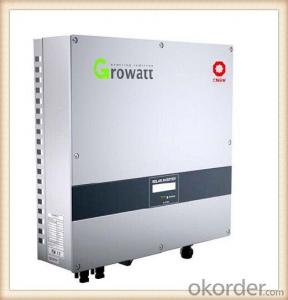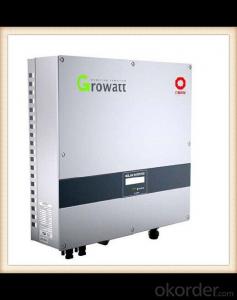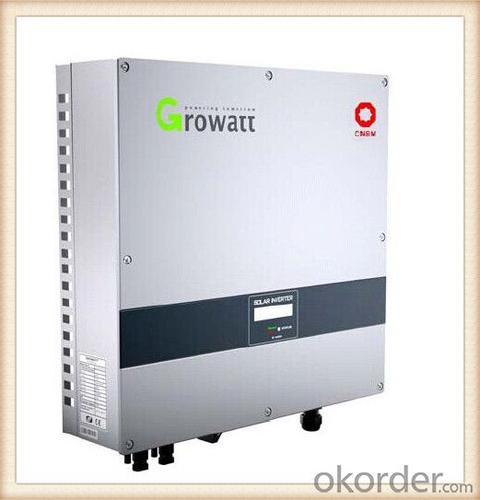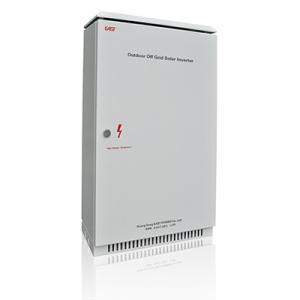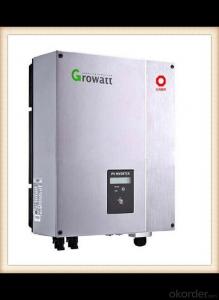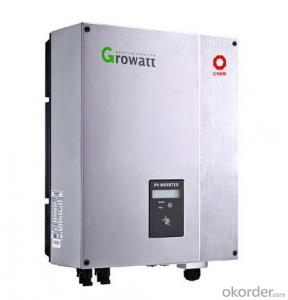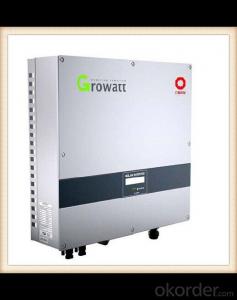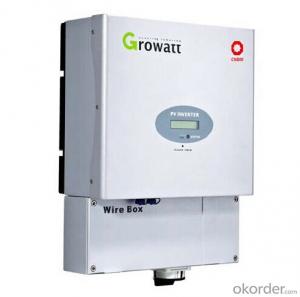Solar Inverter China CNBM-4000TL Grid-Tie Solar Inverter with Energy Storage Hybrid Solar Inverter
- Loading Port:
- China main port
- Payment Terms:
- TT OR LC
- Min Order Qty:
- 1000 watt
- Supply Capability:
- 100000 watt/month
OKorder Service Pledge
OKorder Financial Service
You Might Also Like
Introduction
CNBM-1000TL/1500TL/2000TL/3000TL/4000TL/4400TL/5000TL
Pure sine wave output
Microprocessor controlled to guarantee stable charging system
Multiple operations: Grid tie, Off grid, and grid tie with backup
Built-in MPPT solar charger
LCD display panel for comprehensive information
Multiple communication
Green substitution for generators
User adjustable charging current up to 25A
Maximum efficiency of 97.9% and wide
input voltage range
Wide MPPT voltage
Internal DC switch
Transformerless GT topology
Compact design
MTL – String
Multi-MPPT
Certificate: CE, VDE 0126-1-1,
DK5940, G83/1-1, G59/2, RD1663,
EN50438, VDE-AR-N4105, CEI-021,
IEC-62109, ENEL-Guide, UL1741,
UL1998, IEEE1547, CSA
Warranty: 5/10 years
Features
Maximum efficiency of 96.9% and wide input voltage range
Internal DC switch
MTL-String
Bluetooth/RF technology /wifi
Transformerless GT topology
5 years warranty(10years as optional)
Images
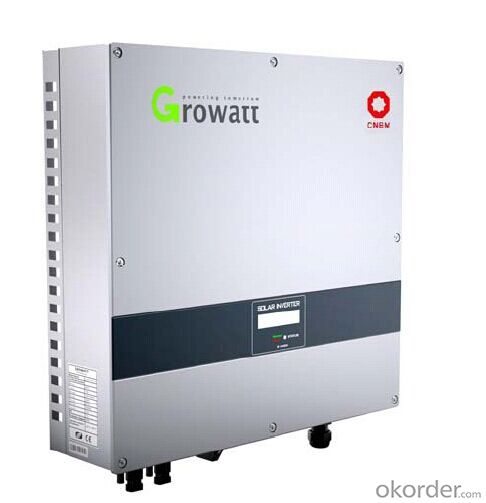
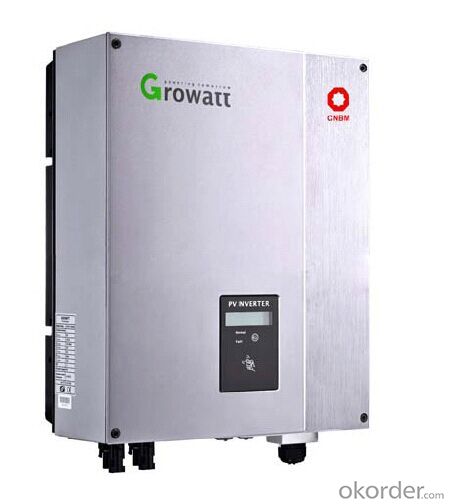
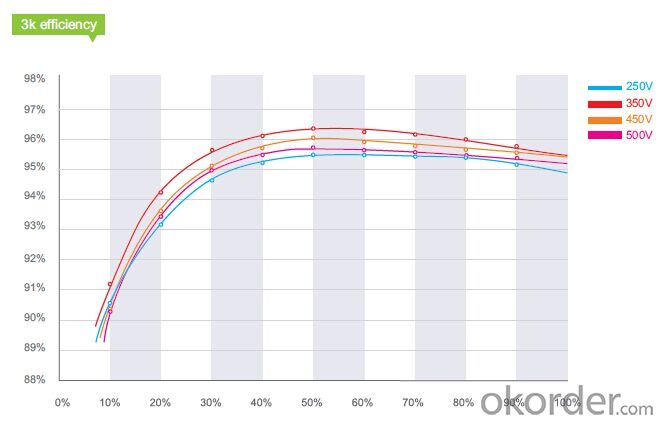
Sepecification
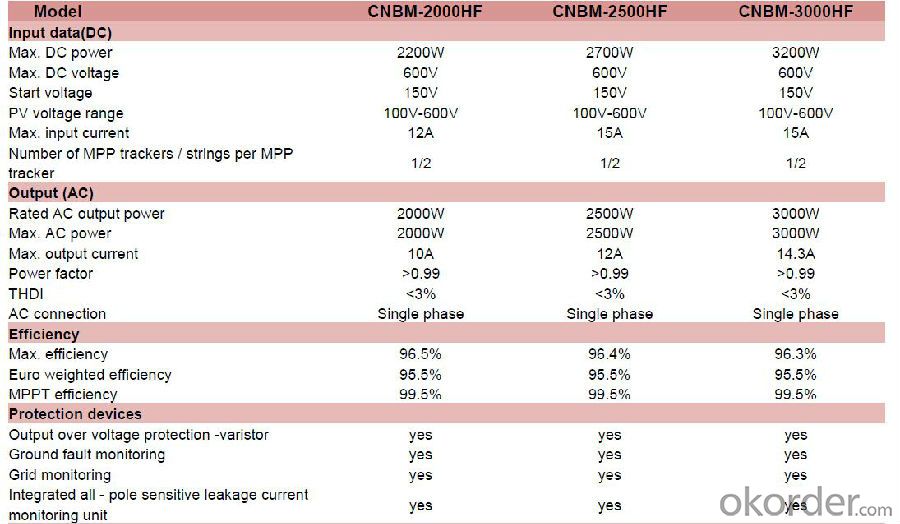
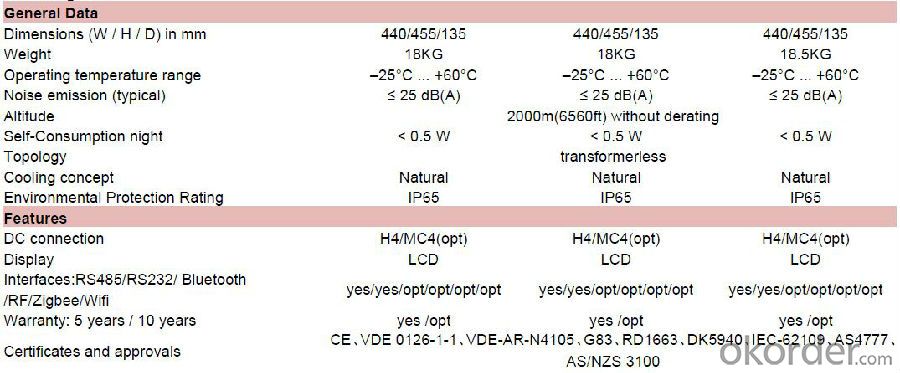
FAQ
Q1: How to choose a right inverter?
A1:Tell us your demand, then our sales will recommend a suitable inverter to you.
Q2: What's the different between inverter and solar inverter?
A2: Inverter is only accept AC input, but solar inverter not only accept AC input but also can connect with solar panel to accept PV input, it more save power.
Q3: How about the delivery time?
A3: 7 days for sample; 25 days for bulk order.
Q4: What is the warranty of inverter?
A4: 5/10 years warranty on CNBM-Solar product.
Q5: How to solve the technical problem?
A5: 24 hours after-service consultancy just for you and to make your problem to solve easily.
- Q: Are there any limitations on the number of solar panels that can be connected to a single inverter?
- Yes, there are limitations on the number of solar panels that can be connected to a single inverter. The maximum number of panels that can be connected depends on the inverter's capacity and the total wattage of the panels. It is important to ensure that the combined wattage of the panels does not exceed the inverter's maximum input capacity to avoid any potential performance issues or damage to the system.
- Q: Can a solar inverter be integrated with energy management systems?
- Yes, a solar inverter can be integrated with energy management systems. Solar inverters can be connected to energy management systems to monitor and control the generation and consumption of solar energy. This integration allows for better optimization of energy usage, real-time monitoring of solar production, and intelligent management of energy flows within a building or grid.
- Q: How does a solar inverter handle fluctuations in solar panel output?
- A solar inverter handles fluctuations in solar panel output by continuously monitoring the voltage and current from the panels. It adjusts the input parameters to maintain a stable output power, compensating for variations in sunlight intensity, temperature changes, and other environmental factors. This ensures a consistent and reliable supply of electricity from the solar panels to the connected electrical load or the grid.
- Q: Can a solar inverter be used with a solar-powered remote monitoring system?
- Yes, a solar inverter can be used with a solar-powered remote monitoring system. The solar inverter is responsible for converting the DC (direct current) electricity generated by the solar panels into AC (alternating current) electricity that can be used to power various devices, including the remote monitoring system. This allows the system to operate efficiently and effectively, ensuring that the solar-powered remote monitoring system functions properly and provides real-time data monitoring.
- Q: What is the role of transformerless design in a solar inverter?
- The role of transformerless design in a solar inverter is to eliminate the need for a bulky and expensive transformer, resulting in a more compact, lightweight, and cost-effective solution. Transformerless inverters use advanced electronic circuitry to convert the direct current (DC) generated by solar panels into alternating current (AC) that can be used to power household appliances or fed back into the grid. This design allows for higher efficiency, lower energy losses, and increased flexibility in system design and installation.
- Q: What is the role of a grid monitoring feature in a solar inverter?
- The role of a grid monitoring feature in a solar inverter is to constantly monitor the electrical grid for voltage, frequency, and other parameters. This feature ensures that the solar inverter is synchronized with the grid and operates within the specified limits. It helps in maintaining a stable and reliable connection between the solar system and the grid, preventing any damage to the inverter or the grid. Additionally, grid monitoring also enables the solar inverter to detect any faults or abnormalities in the grid and take appropriate measures to protect the system and ensure safe operation.
- Q: How do I choose the right solar inverter for my system?
- When choosing the right solar inverter for your system, there are a few key factors to consider. Firstly, you need to determine the size and capacity of your solar panel system. This will help you determine the appropriate power rating for the inverter. Additionally, consider the type of inverter you need - string inverters are suitable for larger systems, while microinverters or power optimizers may be more suitable for smaller or shaded systems. It is also important to check the inverter's efficiency, warranty, and compatibility with your solar panels and battery storage, if applicable. Lastly, consider your budget and any specific features you may require, such as monitoring capabilities or grid-tied functionality. Consulting with a professional solar installer can also provide valuable guidance in selecting the right solar inverter for your specific system.
- Q: Can a solar inverter be used with a monitoring system?
- Yes, a solar inverter can be used with a monitoring system. In fact, many solar inverters come with built-in monitoring capabilities, allowing users to track and analyze the performance of their solar energy system in real-time. Additionally, there are also external monitoring systems available that can be connected to the solar inverter to provide more detailed data and insights on energy production, consumption, and system efficiency.
- Q: Can a solar inverter be used in systems with multiple inverters?
- Yes, a solar inverter can be used in systems with multiple inverters. In fact, using multiple inverters in a solar system is quite common, especially in larger installations. Multiple inverters allow for better power distribution and efficiency, as well as redundancy in case of any failures. These inverters can be connected in parallel or in series depending on the specific system requirements and design.
- Q: Can a solar inverter be used with a solar-powered food dehydrator?
- Yes, a solar inverter can be used with a solar-powered food dehydrator. The solar inverter helps convert the direct current (DC) produced by the solar panels into alternating current (AC) that can be used by the food dehydrator. This allows the dehydrator to operate using the energy generated by the solar panels, making it an efficient and sustainable option for food dehydration.
Send your message to us
Solar Inverter China CNBM-4000TL Grid-Tie Solar Inverter with Energy Storage Hybrid Solar Inverter
- Loading Port:
- China main port
- Payment Terms:
- TT OR LC
- Min Order Qty:
- 1000 watt
- Supply Capability:
- 100000 watt/month
OKorder Service Pledge
OKorder Financial Service
Similar products
Hot products
Hot Searches
Related keywords
